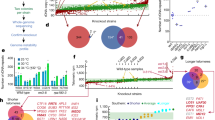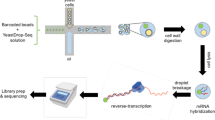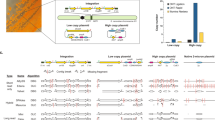Key Points
-
Genomic technologies have altered the way in which we use molecular biology; the budding yeast Saccharomyces cerevisiae, because of its compact genome and tractable genetics, has emerged as a preferred model for developing these new technologies.
-
This review discusses the most promising of these emerging technologies, which include:
-
The use of multipurpose transposons to generate genome-wide insertional mutations to study gene expression, gene function and protein localization.
-
The development of microarray technology to study genome-wide changes in the expression of all annotated yeast genes during certain biological processes or conditions, and for systematically mapping the chromosomal binding sites of DNA-binding proteins.
-
The use of large-scale two-hybrid studies to generate a global protein–protein interaction map in yeast.
-
The application of biochemical genomics to generating proteins and to assaying their functions on a genome-wide scale.
-
New approaches to generating protein microarrays, which allow functionally active proteins to be fixed onto a solid support for large-scale functional analysis.
-
The use of mass spectrometry to identify proteins in complex protein mixtures.
-
These approaches have benefited from bioinformatic resources that are widely available to the yeast genetics community, such as curated databases and online data sets, which, in the future, will help to continue the rapid rate at which new yeast genomics technologies are developed.
Abstract
The genomic revolution is undeniable: in the past year alone, the term 'genomics' was found in nearly 500 research articles, and at least 6 journals are devoted solely to genomic biology. More than just a buzzword, molecular biology has genuinely embraced genomics (the systematic, large-scale study of genomes and their functions). With its facile genetics, the budding yeast Saccharomyces cerevisiae has emerged as an important model organism in the development of many current genomic methodologies. These techniques have greatly influenced the manner in which biology is studied in yeast and in other organisms. In this review, we summarize the most promising technologies in yeast genomics.
This is a preview of subscription content, access via your institution
Access options
Subscribe to this journal
Receive 12 print issues and online access
$189.00 per year
only $15.75 per issue
Buy this article
- Purchase on Springer Link
- Instant access to full article PDF
Prices may be subject to local taxes which are calculated during checkout





Similar content being viewed by others
References
Fleischmann, R. D. et al. Whole-genome random sequencing and assembly of Haemophilus influenzae Rd. Science 269, 496– 512 (1995).
Goffeau, A. et al. Life with 6000 genes. Science 274, 546, 563–567 (1996).
Hieter, P. & Boguski, M. Functional genomics: it's all how you read it. Science 278, 601– 602 (1997).
Costanzo, M. C. et al. The yeast proteome database (YPD) and Caenorhabditis elegans proteome database (WormPD): comprehensive resources for the organization and comparison of model organism protein information. Nucleic Acids Res. 28, 73–76 ( 2000).
Bassett, D. E., Boguski, M. S. & Hieter, P. Yeast genes and human disease. Nature 379, 589–590 (1996).
Bassett, D. E. et al. Genome cross-referencing and XREFdb: implications for the identification and analysis of genes mutated in human disease. Nature Genet. 15, 339–344 (1997).
Venter, J. C. et al. The sequence of the human genome. Science 291, 1304–1351 (2001).
The Genome International Sequencing Consortium. Initial sequencing and analysis of the human genome. Nature 409, 860–921 (2001).
Oliver, S. G. From DNA sequence to biological function. Nature 379 , 597–600 (1996).
Devine, S. E. & Boeke, J. D. Efficient integration of artificial transposons into plasmid targets in vitro: a useful tool for DNA mapping, sequencing and genetic analysis. Nucleic Acids Res. 22, 3765–3772 (1994).
Garfinkel, D. J. Insertional mutagenesis by Ty elements in Saccharomyces cerevisiae. Methods Mol. Biol. 53, 227–237 (1996).
Gwinn, M. L., Stellwagen, A. E., Craig, N. L., Tomb, J.-F. & Smith, H. O. In vitro TN7 mutagenesis of Haemophilus influenzae Rd and characterization of the role of atpA in transformation. J. Bacteriol. 179, 7315– 7320 (1997).
Burns, N. et al. Large-scale characterization of gene expression, protein localization and gene disruption in Saccharomyces cerevisiae. Genes Dev. 8, 1087–1105 ( 1994).
Smith, V., Botstein, D. & Brown, P. O. Genetic footprinting: a genomic strategy for determining a gene's function given its sequence. Proc. Natl Acad. Sci. USA 92, 6479–6483 ( 1995).
Ross-Macdonald, P., Sheehan, A., Roeder, G. S. & Snyder, M. A multipurpose transposon system for analyzing protein production, localization, and function in Saccharomyces cerevisiae. Proc. Natl Acad. Sci. USA 94, 190–195 ( 1997).
Ross-MacDonald, P. et al. Large-scale analysis of the yeast genome by transposon tagging and gene disruption. Nature 402, 413– 418 (1999).The use of shuttle mutagenesis with multipurpose transposons in a genome-wide analysis of disruption phenotypes, gene expression and protein localization.
Hoekstra, M. F. et al. A Tn3 derivative that can be used to make short in-frame insertions within genes. Proc. Natl Acad. Sci. USA 88, 5457–5461 (1991).
Biery, M. C., Stewart, F. J., Stellwagen, A. E., Raleigh, E. A. & Craig, N. L. A simple in vitro Tn7-based transposition system with low target site selectivity for genome and gene analysis. Nucleic Acids Res. 28, 1067–1077 (2000).
Seifert, H. S., Chen, E. Y., So, M. & Heffron, F. Shuttle mutagenesis: a method of transposon mutagenesis for Saccharomyces cerevisiae. Proc. Natl Acad. Sci. USA 83, 735– 739 (1986).
Ross-Macdonald, P., Sheehan, A., Friddle, C., Roeder, G. S. & Snyder, M. Transposon mutagenesis for the analysis of protein production, function, and localization. Methods Enzymol. 303, 512–532 (1999).
Kumar, A., des Etages, S. A., Coelho, P. S. R., Roeder, G. S. & Snyder, M. High-throughput methods for the large-scale analysis of gene function by transposon tagging . Methods Enzymol. 328, 550– 574 (2000).
Chu, S. et al. The transcriptional program of sporulation in budding yeast. Science 282, 699–705 ( 1998).
Kumar, A. et al. TRIPLES: a database of gene function in Saccharomyces cerevisiae . Nucleic Acids Res. 28, 81– 84 (2000).
Davies, C. J. & Hutchison, C. A. Insertion site specificity of the transposon Tn3. Nucleic Acids Res. 23, 507–514 (1995).
Winzeler, E. A. et al. Functional characterization of the S. cerevisiae genome by gene deletion and parallel analysis. Science 285 , 901–906 (1999). A report on the progress of an international consortium that disrupted each annotated open reading frame in the yeast genome using a targeted PCR-based gene-deletion strategy.
Baudin, A., Ozier-Kalogeropoulos, O., Denouel, A., Lacroute, F. & Cullin, C. A simple and efficient method for direct gene deletion in Saccharomyces cerevisiae. Nucleic Acids Res. 21, 3329–3330 (1993).
Shoemaker, D. D., Lashkari, D. A., Morris, D., Mittmann, M. & Davis, R. W. Quantitative phenotypic analysis of yeast deletion mutants using a highly parallel molecular bar-coding strategy . Nature Genet. 14, 450– 456 (1996).
Hughes, T. R. et al. Widespread aneuploidy revealed by DNA microarray expression profiling. Nature Genet. 25, 333– 337 (2000).
Chan, T.-F., Carvalho, J., Riles, L. & Zheng, X. F. S. A chemical genomics approach toward understanding the global functions of the target of rapamycin protein (TOR). Proc. Natl Acad. Sci. USA 97, 13227–13232 (2000).
Giaever, G. et al. Genomic profiling of drug sensitivities via induced haploinsufficiency . Nature Genet. 21, 278– 283 (1999).
Schena, M., Shalon, D., Davis, R. W. & Brown, P. O. Quantitative monitoring of gene expression patterns with a complementary DNA microarray . Science 270, 467–470 (1995).
Chee, M. et al. Accessing genetic information with high-density DNA arrays. Science 274, 610–614 ( 1996).
DeRisi, J. L., Iyer, V. R. & Brown, P. O. Exploring the metabolic and genetic control of gene expression on a genomic scale. Science 278, 680–686 (1997).
Cho, R. J. et al. A genome-wide transcriptional analysis of the mitotic cell cycle. Mol. Cell 2, 65– 73 (1998).
Spellman, P. T. et al. Comprehensive identification of cell cycle-regulated genes of the yeast Saccharomyces cerevisiae by microarray hybridization. Mol. Biol. Cell 9, 3273–3297 (1998).
Jelinsky, S. A. & Samson, L. D. Global response of Saccharomyces cerevisiae to an alkylating agent. Proc. Natl Acad. Sci. USA 96, 1486–1491 (1999).
Madhani, H. D., Galitski, T., Lander, E. S. & Fink, G. R. Effectors of a developmental mitogen-activated protein kinase cascade revealed by expression signatures of signaling mutants. Proc. Natl Acad. Sci. USA 96, 12530–12535 (1999).
Holstege, F. C. P. et al. Dissecting the regulatory circuitry of a eukaryotic genome . Cell 95, 717–728 (1998).
Hughes, T. R. et al. Functional discovery via a compendium of expression profiles . Cell 102, 109–126 (2000).
Roberts, C. J. et al. Signaling and circuitry of multiple MAPK pathways revealed by a matrix of global gene expression profiles. Science 287, 873–878 (2000).
Jelinsky, S. A., Estep, P., Church, G. M. & Samson, L. D. Regulatory networks revealed by transcriptional profiling of damaged Saccharomyces cerevisiae cells: Rpn4 links base excision repair with proteasomes. Mol. Cell. Biol. 20, 8157–8167 (2000).
Iyer, V. R. et al. Genomic binding distribution of the yeast cell-cycle transcription factors SBF and MBF. Nature 409, 533– 538 (2001).
Ren, B. et al. Genome-wide location and function of DNA binding proteins. Science 290, 2306–2309 ( 2000).References 42 and 43 describe a new genomic approach that combines chromatin immunoprecipitation and microarray hybridization to map the binding sites of chromosomal proteins in vivo.
Gerton, J. L. et al. Global mapping of meiotic recombination hotspots and coldspots in the yeast Saccharomyces cerevisiae. Proc. Natl Acad. Sci. USA 97, 11383–11390 (2000).
Baudat, F. & Nicolas, A. Clustering of meiotic double-strand breaks on yeast chromosome III. Proc. Natl Acad. Sci. USA 94, 5213–5218 (1997).
Fromont-Racine, M., Rain, J. C. & Legrain, P. Toward a functional analysis of the yeast genome through exhaustive two-hybrid screens. Nature Genet. 16, 277–282 (1997).
Ito, T. et al. Toward a protein–protein interaction map of the budding yeast: a comprehensive system to examine two-hybrid interactions in all possible combinations between the yeast proteins. Proc. Natl Acad. Sci. USA 97, 1143–1147 ( 2000).
Uetz, P. et al. A comprehensive analysis of protein–protein interactions in Saccharomyces cerevisiae. Nature 403, 623–627 (2000).References 47 and 48 describe large-scale applications of the two-hybrid approach towards identifying protein–protein interactions in yeast.
Fields, S. & Song, O. A novel genetic system to detect protein–protein interactions. Nature 340, 245– 246 (1989).
Brent, R. & Finley, R. L. Understanding gene and allele function with two-hybrid methods. Annu. Rev. Genet. 31, 663–704 (1997).
Heyman, J. A. et al. Genome-scale cloning and expression of individual open reading frames using topoisomerase I-mediated ligation. Genome Res. 9, 383–392 (1999).
Martzen, M. R. et al. A biochemical genomics approach for identifying genes by the activity of their products. Science 286, 1153–1155 (1999). A genome-wide biochemical approach to identifying gene function.
Arenkov, P. et al. Protein microchips: use for immunoassay and enzymatic reactions . Anal. Biochem. 278, 123– 131 (2000).
MacBeath, G. & Schreiber, S. L. Printing proteins as microarrays for high-throughput function determination. Science 289, 1760–1763 (2000).
Zhu, H. et al. Analysis of yeast protein kinases using protein chips. Nature Genet. 26, 283–289 (2000).References 53 – 55 describe three new protein microarray methodologies for high-throughput protein analysis.
Futcher, B., Latter, G. I., Monardo, P., McLaughlin, C. S. & Garrels, J. I. A sampling of the yeast proteome . Mol. Cell. Biol. 19, 7357– 7368 (1999).
Perrot, M. et al. Two-dimensional gel protein database of Saccharomyces cerevisiae (update 1999). Electrophoresis 20, 2280–2298 (1999).
Wigge, P. A. et al. Analysis of the Saccharomyces spindle pole by matrix-assisted laser desorption/ionization (MALDI) mass spectrometry. J. Cell Biol. 141, 967–977 ( 1998).
Rout, M. P. et al. The yeast nuclear pore complex: composition, architecture, and transport mechanism. J. Cell Biol. 148, 635–651 (2000).
Link, A. J. et al. Direct analysis of protein complexes using mass spectrometry . Nat Biotechnol. 17, 676– 682 (1999).
Gygi, S. P. et al. Quantitative analysis of complex protein mixtures using isotope-coded affinity tags. Nat Biotechnol. 17, 994– 999 (1999). A powerful approach to quantitative protein analysis using isotope-coded affinity tags and mass spectrometry.
Raamsdonk, L. M. et al. A functional genomics strategy that uses metabolome data to reveal the phenotype of silent mutations. Nat Biotechnol. 19, 45–50 (2001).
Pease, A. C. et al. Light-generated oligonucleotide arrays for rapid DNA sequence analysis. Proc. Natl Acad. Sci. USA 91, 5022–5026 (1994).
Marton, M. J. et al. Drug target validation and identification of secondary drug target effects using DNA microarrays. Nature Med. 4 , 1293–1301 (1998).
Eisen, M. B., Spellman, P. T., Brown, P. O. & Botstein, D. Cluster analysis and display of genome-wide expression patterns. Proc. Natl Acad. Sci. USA 95, 14863– 14868 (1998).
Tamayo, P. et al. Interpreting patterns of gene expression with self-organizing maps: methods and application to hematopoietic differentiation. Proc. Natl Acad. Sci. USA 96, 2907– 2912 (1999).
Everitt, B. Cluster Analysis Vol. 122 (Heinemann, London, 1974).
Heyer, L. J., Kruglyak, S. & Yooseph, S. Exploring expression data: identification and analysis of coexpressed genes. Genome Res. 9, 1106 –1115 (1999).
Brown, M. P. et al. Knowledge-based analysis of microarray gene expression data by using support vector machines. Proc. Natl Acad. Sci. USA 97, 262–267 (2000).
Tavazoie, S., Hughes, J. D., Campbell, M. J., Cho, R. J. & Church, G. M. Systematic determination of genetic network architecture. Nature Genet. 22, 281–285 (1999).
Acknowledgements
A.K. is supported by a postdoctoral fellowship from the American Cancer Society.
Author information
Authors and Affiliations
Supplementary information
Related links
Related links
DATABASE LINKS
Saccharomyces Genome Database (SGD) (Function Junction)
Munich Information Centre for Protein Sequences (MIPS)
Transposon mutagenesis/tagging
Stanford cell-cycle microarray data set
Rick Young's microarray data set
Stan Field's two-hybrid data set
Yeast protein function assignment
FURTHER INFORMATION
ENCYCLOPEDIA OF LIFE SCIENCES
Glossary
- FUNCTIONAL GENOMICS
-
The development and systematic application of experimental methodologies to analyse gene function on a genome-wide scale.
- TRANSPOSON
-
Mobile DNA elements that can relocate within the genome of their hosts; transposons can be used for various applications, including insertional mutagenesis, gene identification, gene tagging and DNA sequencing.
- EPITOPE
-
Part of a protein (antigen) that combines with the antigen-binding site of an antibody; the incorporation of an epitope-encoding sequence into a target gene is called epitope-tagging.
- SHUTTLE MUTAGENESIS
-
A method in which cloned yeast genes are mutated by bacterial transposition in Escherichia coli; mutant alleles are subsequently introduced ('shuttled') into yeast where they integrate at their corresponding genomic loci by homologous recombination.
- CONDITIONAL MUTATIONS
-
Mutations that generate an observable mutant phenotype under a given set of growth conditions (restrictive conditions), but no mutant phenotype (or a reduced phenotype) under a separate set of conditions (permissive conditions).
- ESSENTIAL GENE
-
A gene that is indispensable for cell viability under defined growth conditions; complete loss of the function of an essential gene is lethal.
- HETEROZYGOUS DIPLOID
-
A diploid yeast cell with different alleles at a particular locus. Heterozygous diploid cells can be used to ascribe cellular functions to essential genes.
- HAPLOINSUFFICIENCY
-
When loss of function of one gene copy leads to a mutant phenotype.
- PROTEOMICS
-
The development and systematic application of experimental methodologies to analyse the entire protein complement of an organism (its 'proteome').
- CONTACT PRINTING
-
A method of microarray generation in which samples are spotted onto a slide using specialized spring-loaded printing tips; liquid is drawn up into the printing tip by capillary action and subsequently deposited on contact with the surface of the slide.
- PEPTIDE LIBRARIES
-
A collection of small polypeptides that might be used to assay protein function.
- ISOELECTRIC POINT
-
The pH at which a molecule is electrically neutral (the sum of its positive charges equals the sum of its negative charges).
Rights and permissions
About this article
Cite this article
Kumar, A., Snyder, M. Emerging technologies in yeast genomics. Nat Rev Genet 2, 302–312 (2001). https://doi.org/10.1038/35066084
Issue Date:
DOI: https://doi.org/10.1038/35066084
This article is cited by
-
Genomic and transcriptomic analyses of the Chinese Maotai-flavored liquor yeast MT1 revealed its unique multi-carbon co-utilization
BMC Genomics (2015)
-
Whole-genome microarrays of fission yeast: characteristics, accuracy, reproducibility, and processing of array data
BMC Genomics (2003)
-
ORFeomics: correcting the wiggle in worm genes
Nature Genetics (2003)
-
Treasures and traps in genome-wide data sets: case examples from yeast
Nature Reviews Genetics (2002)



